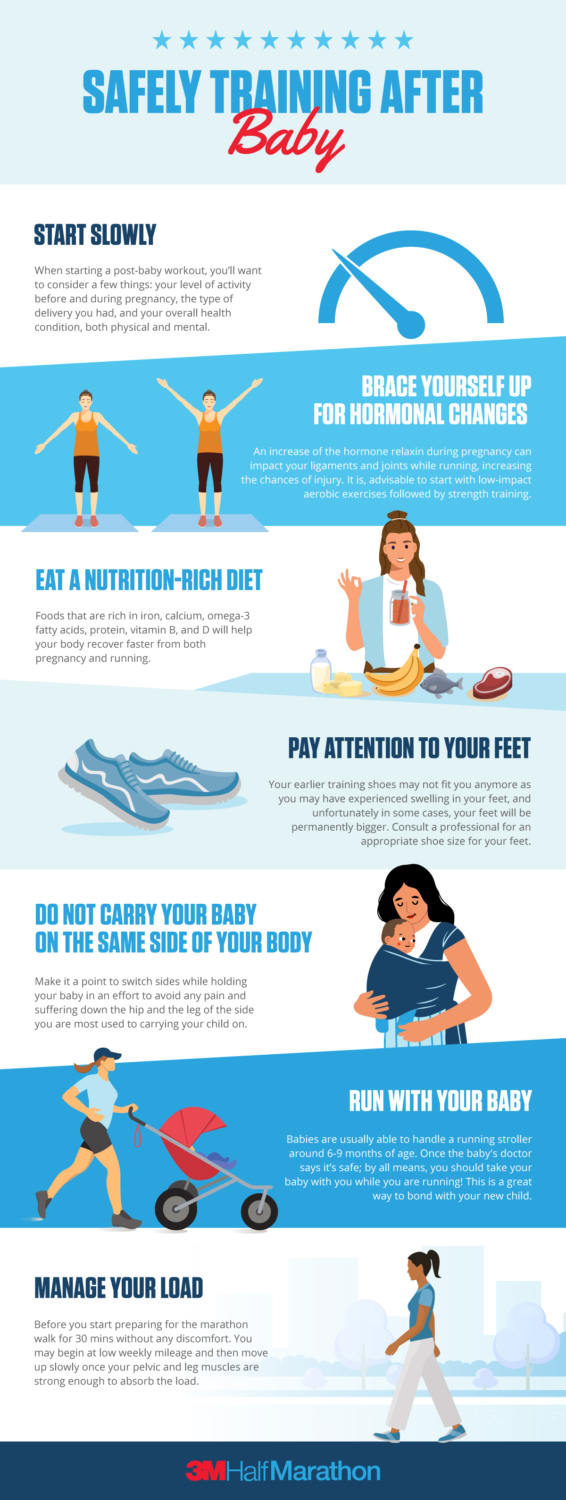Giving birth to a baby is like no other experience in this world. It is highly gratifying to nurture a life inside you and then bring them into this world. Returning to running after pregnancy will require consideration of the demand your body has been through both emotionally and physically.
On the other, pregnancy also takes a heavy toll on you both physically and emotionally. The period that immediately follows childbirth (postpartum) can be equally taxing. Sliding back to normalcy and getting back into your previous running routine may take some time.
Luckily, we’re here with some tips that may help get you back to training for a half marathon sooner than you think.

Start slowly & be realistic
Whether you are deciding to start training during pregnancy or after childbirth, the first thing you should do is discuss your plan with your doctor. For hassle-free pregnancies, your doctor may recommend weekly strength training or aerobic exercises. During the pregnancy/postpartum period, your body undergoes a lot of cardiovascular changes, resulting in more oxygen circulating through the body. This means your body is functioning more efficiently and you can use that to your advantage.
However, whether during pregnancy or postpartum it is important to keep the intensity level of your exercise in mind. When starting a post-baby workout, you’ll want to consider a few things: your level of activity before and during pregnancy, the type of delivery you had, and your overall health condition, both physical and mental. It is recommended you do not go into overdrive with your training schedule post-delivery.
Brace yourself up for hormonal changes
The increased release of the hormone relaxin during pregnancy (and also while breastfeeding) results in the pelvic floor becoming more relaxed. This, in turn, may also impact your ligaments and joints while running, increasing the chances of injury. It is, therefore, advisable to start with low-impact aerobic exercises followed by strength training. These will help strengthen your muscles and prep you for a better training regimen in the future.
Eat a nutrition-rich diet
Try to incorporate food items that are rich in iron, calcium, omega-3 fatty acids, protein, vitamin B, and D. These will help your body recover faster from both pregnancy and running. Iron and electrolytes are especially helpful in avoiding dehydration, and if you are breastfeeding they also help prevent a drop in breastmilk production. Here are some healthy and easy breakfast ideas that fit the bill, try them out!
Pay attention to your feet
Your earlier training shoes may not fit you anymore as you may have experienced swelling in your feet, and unfortunately in some cases, your feet will be permanently bigger. Consult a professional for an appropriate shoe size for your feet.
Do not carry your baby on the same side of your body
Make it a point to switch sides while holding your baby. Otherwise, when you start intensifying your exercise after delivery your lower back muscles may soon give up on you. This may lead to immense pain and suffering down the hip and the leg of the side you are most used to carrying your child on.
Run with your baby
Babies are usually able to handle a running stroller around 6-9 months of age. Once the baby’s doctor says it’s safe; by all means, you should take your baby with you while you are running! This is a great way to bond with your new child. Just be sure to buckle them in safely according to the standards of your running stroller. Head here for some helpful tips about running with a stroller.
Manage your load
Before you start preparing for the marathon, walk for 30 minutes without any discomfort. Once you are comfortably walking at this pace and time increment for a few weeks you can then start slowly running. You may begin at low weekly mileage and then move up slowly. You may gradually increase your speed too once your pelvic and leg muscles are strong enough to absorb the load.
By following the above guidelines, you will find yourself back to a normal training routine in no time. Just remember not to push yourself too hard; listen to your body, start slow, and stay hydrated. Through a healthy and productive training regimen, you’ll be back running a marathon in no time.
